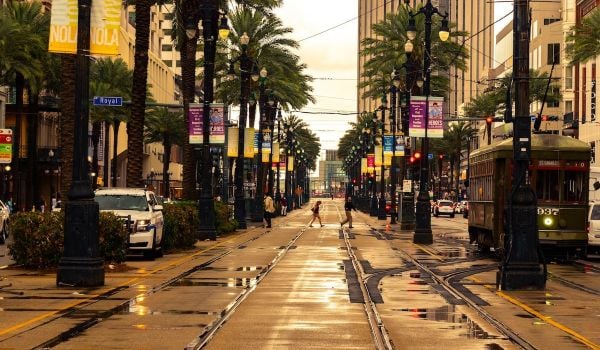During the initial months of President Donald Trump’s term, activists around the country raised their voices calling for the removal of monuments to the U.S. Confederacy. New Orleans became a focal point for this campaign with local groups like Take ‘Em Down NOLA pushing city officials to eliminate all symbols of white supremacy. Not everyone agreed. The contractor originally hired to do the work resigned after receiving death threats finding his car burned.
Thus far, New Orleans has removed four Confederate monuments, but instead of rushing to fill those empty pedestals, the city hit the pause button in order to reflect on the best way to replace them. The Paper Monuments project, a participatory imagining of the monuments New Orleanians would like, stepped into that pause to involve New Orleanians in the conversation about what should come next.
The Paper Monuments project was a two-year process that asked New Orleanians to describe and draw new monuments they would like to see. Sue Mobley, director of advocacy at the non-profit multidisciplinary design practice that ran the project, says Paper Monuments also aimed to challenge the idea that monuments must be in stone or bronze. So, for example, some of the “monuments” eventually created were posters representing people, places and historical events. Others were three-dimensional installations made of wood, paper and other materials. Henriette Delille, a free woman of color who founded a religious institute that ministered to the poor, was featured on one poster as was the Enslaved People’s Uprising of 1811, the largest insurrection by enslaved people in the history of the United States.
In mid-October, Colloqate published a report reflecting on the Paper Monuments experience and the lessons gleaned from it.
Paper Monuments was a way to both write and “right” history, says Mobley.
“What we wanted to do was to present histories that were more complicated or that were more challenging, and to lift up the people who don’t get monuments, the stories that don’t get told,” Mobley says. That meant focusing on the histories of working class, LGBTQ, female, black and immigrant New Orleanians. Highlighting these stories, for example, meant creating posters depicting events such as the standoff between police and the Black Panther Party at the Desire Projects in 1970, which involved a tank.
The project engaged a broad range of residents, Mobley says. During one period, the project collected suggestions and thoughts from people who came to City Hall. The group set up a table in the foyer to engage people coming to meetings or to complain about issues. Academics also participated by writing texts and sharing knowledge of historical events.
Along with asking for input into the kinds of monuments people would like to see, Paper Monuments also used posters and three-dimensional installations to engage New Orleanians on the street. For example, one of the project’s most visible installations was a series of wheatpasted, large-scale galleries posted at transit stops along the Canal Street corridor. Paper Monuments also developed a city-wide scavenger hunt called “Framing History” that created installations near the sites of historic events.

(Courtesy Paper Monuments Project)
Mobley recalls one “self-appointed docent” who would engage with transit riders at one gallery. “He was a street sweeper for the Downtown Development District, but he had been at the Desire showdown. He had been a kid in the Panther’s breakfast program and was being trained to administer the program.” Mobley says the “docent” used his own experience to engage with young people waiting for the bus, but he had also read all of the histories the posters shared. “He was using it so well as a teaching tool and as a point to interrogate with kids, ‘Why is it we don’t see our histories up on the wall, but we see ads? Why do we see things we are supposed to consume and buy instead of how we’re supposed to be in the world?’” Mobley recalls.
The posters presented a very different view of New Orleans than is typically offered. “As New Orleans reflects upon itself, it’s making use of a very romanticized, very simplified history and one that erases immigrant groups that aren’t French; one that centers a ‘racial relations were different here.’ And one that erases class distinctions entirely,” says Mobley.
Mobley sees these idealized stories about New Orleans’ history and culture as problematic. The “tourist narrative,” she says, “has been refined over the past century as New Orleans has become more dependent on tourism.” The challenge Mobley sees is that this “tourist narrative” has become pervasive and also influences scholarly work.
A few years before the public pressure brought the Confederate monuments down, Mobley co-organized a conference at Tulane University called “New Orleans as Subject.” The idea behind that conference was to question the popular tourist narrative, says Mobley. She credits this conference as the wellspring of the Paper Monuments project, which got under way in 2017.
Another story featured in the posters Paper Monuments created featured the Dew Drop Inn, an historic bar and night club in the Central City neighborhood. Hannah Chalew, an artist and long-time New Orleans resident, created the poster.
“During segregation, [the Dew Drop Inn] was a venue for Black musicians to perform, then also a hotel for them to stay in,” says Chalew. “It was also like a laundromat. It was kind of like a community center,” she says. The club’s owner supported integration and so allowed white patrons into the club along with black folk. Performers like Ray Charles and Lil’ Richard played the club and lived there. To enforce Jim Crow laws, police would raid the club and arrest patrons and the owner. Pania was charged with disturbing the peace in 1952 for serving blacks and whites together. Although the charges were dismissed, Pania continued to fight. He sued the city shortly before the 1964 Civil Rights Act passed and rendered Jim Crow laws illegal.
Heidi Schmalbach, executive director of The New Orleans Arts Council, says the project helped bring stories like these to the fore. “Paper Monuments became this really brilliant and surprisingly simple … process to involve as many people as possible in how we want to represent our collective history in our shared space,” Schmalbach says.
The New Orleans Public Library was instrumental in helping Paper Monuments connect with residents. The relationship grew from an initial “draw-a-thon” that the group held at the main branch, says April Martin, who ran the library’s adult programs at the time.
“They wanted an open space at the library for a few hours where anyone could come, propose monuments, explore books about equity, sit together and talk and draw them out on their forms,” Martin says.
That initial public engagement session led to others as library branches around the city hosted similar events. Martin says that once the first group of posters had been printed, the library also became a distribution hub for them. She says that while most patrons didn’t know about them the first year, by the second year, they were in high demand.
“Teachers throughout the city wanted a full set for their classrooms,” Martin recalls. “They were building curriculum around the posters, so they would call us to hold one [set for them].”
This article is part of “For Whom, By Whom,” a series of articles about how creative placemaking can expand opportunities for low-income people living in disinvested communities. This series is generously underwritten by the Kresge Foundation.

Zoe Sullivan is a multimedia journalist and visual artist with experience on the U.S. Gulf Coast, Argentina, Brazil, and Kenya. Her radio work has appeared on outlets such as BBC, Marketplace, Radio France International, Free Speech Radio News and DW. Her writing has appeared on outlets such as The Guardian, Al Jazeera America and The Crisis.
Follow Zoe .(JavaScript must be enabled to view this email address)













